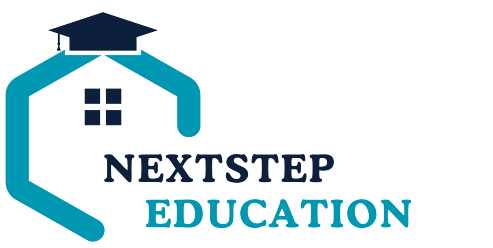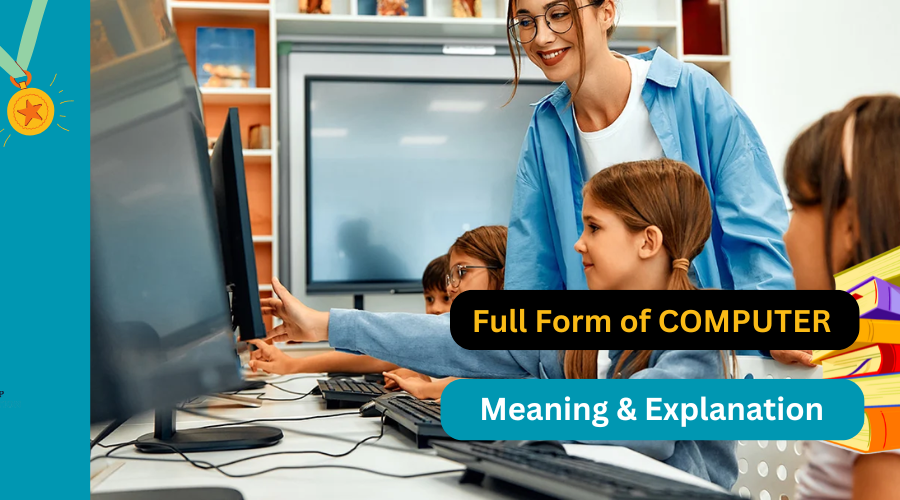A computer is one of the most important inventions of the modern world. We use computers every day for learning, playing, working, and staying connected with others. But have you ever wondered what the word COMPUTER actually stands for? Many students and parents are curious about the full form of computer in English because it’s often taught in schools as a fun way to remember what a computer does.
In this blog, you’ll learn the popular computer full form for students, what each letter represents, and what it really means in simple words. You’ll also find an easy explanation for kids, so everyone can understand what a computer is and why it’s such an important tool in our lives.
What is a Computer?
A computer is an electronic device that can receive data (input), process it according to instructions, store it, and then produce results (output). Simply put, a computer helps us perform tasks faster and more accurately than we could on our own.
For example, when you type a word document, the keyboard sends input to the computer, which processes your keystrokes and displays the letters on the screen. Computers are used in schools, homes, offices, hospitals, and almost everywhere because they can handle millions of calculations in seconds.
In simple words for kids: A computer is like a smart machine that helps you do homework, play games, watch videos, or talk to friends online.
Knowing what a computer is helps students understand the computer definition and full form, making technology less confusing and more exciting to learn about.
Easy Explanation for Students and Kids
Understanding the computer full form for kids doesn’t have to be complicated! Let’s make it super easy:
A computer is like a smart helper that you can tell what to do. Think of it as a super-fast calculator, a library, and a game console all in one. Each part of the full form explains how it helps you:
- Commonly Operated Machine – It’s a machine almost everyone uses.
- Particularly Used for Technical Education and Research – It helps you learn, do schoolwork, and find new information.
For example:
- When you use a computer to watch a video about space, it’s helping you with education.
- When scientists use computers to find cures for diseases, that’s research.
- When you use drawing programs or math games, that’s technical learning made fun!
This easy explanation shows that computers aren’t just for adults — they’re amazing tools for students to discover new things, solve problems, and explore the world right from the classroom or home.
What is the Full Form of COMPUTER?
Many students and parents ask, “What is the full form of COMPUTER?” because it’s a fun way to remember what a computer can do. Although the word “COMPUTER” is not officially an acronym, teachers often use a popular expanded form to help kids understand its purpose.
Here’s the most common version of the computer full form with explanation:
- C – Commonly
- O – Operated
- M – Machine
- P – Particularly
- U – Used for
- T – Technical
- E – Education
- R – Research
This full form shows that a computer is a Commonly Operated Machine Particularly Used for Technical Education and Research. It explains how computers are designed to help people work on technical tasks, study, and discover new information.
Remember: This full form is a backronym — meaning it was created after the word “computer” existed, mainly for educational purposes. It’s a great way for students to learn about computers in a simple, memorable way.
Components of a Computer
A computer is made up of several important parts that work together to perform tasks. These components of a computer can be divided into two main categories: hardware and software.
1. Hardware Components
These are the physical parts of a computer you can touch and see:
- Central Processing Unit (CPU)
Often called the “brain of the computer,” it processes instructions and controls other parts of the computer. - Monitor
The screen that displays text, images, videos, and everything you do on the computer. - Keyboard
An input device used to type letters, numbers, and commands into the computer. - Mouse
A pointing device that lets you move the cursor, click on items, and interact with programs. - Motherboard
The main circuit board where the CPU, memory, and other hardware components connect. - Memory (RAM)
Temporary storage that helps the computer run programs quickly while it’s on. - Storage Devices
Hard Disk Drives (HDDs), Solid State Drives (SSDs), or external drives store data like files, documents, photos, and software. - Power Supply Unit (PSU)
Provides electricity to run the computer’s components. - Input/Output Devices
Devices like printers, speakers, microphones, webcams, and USB drives allow you to interact with the computer or expand its functionality.
2. Software Components
These are programs and instructions that tell the computer what to do:
Utility Software
Programs that help maintain, protect, or optimize the computer, like antivirus software or disk cleanup tools.
Operating System (OS)
Examples include Windows, macOS, or Linux. The OS manages the computer’s hardware and software resources.
Application Software
Programs like Microsoft Word, PowerPoint, Photoshop, or web browsers that help you complete specific tasks.
Uses of Computer
Computers have become essential tools in every part of modern life. Here are some of the main uses of computers:
- Education
Computers help students research, complete assignments, attend online classes, and use interactive learning apps. Teachers use computers to prepare lessons and share educational resources. - Communication
Email, video calls, messaging apps, and social media all rely on computers to help people connect instantly across the world. - Business and Office Work
Computers are used for tasks like creating documents, spreadsheets, presentations, and managing customer records. Businesses also use them for online transactions and data analysis. - Healthcare
Hospitals and clinics use computers to keep patient records, perform diagnostic tests, and run life-saving equipment. - Entertainment
Watching movies, listening to music, playing games, and reading books online are all possible because of computers. - Banking and Finance
From ATMs to online banking, computers help manage money safely and efficiently. - Design and Creativity
Computers are used in graphic design, video editing, animation, architecture, and more. - Scientific Research
Scientists use computers for simulations, data analysis, and conducting complex research projects. - Government and Administration
Computers help governments manage services, databases, taxes, and communication with citizens.
Importance of Computer
Here’s why computers are important for students, professionals, and society as a whole:
- Increases Productivity
Computers complete repetitive and complex tasks quickly, saving time and effort. - Access to Information
With a computer and internet, you can learn about almost anything from anywhere in the world. - Enhances Learning
Computers make learning interactive, personalized, and fun through videos, quizzes, and online exercises. - Essential for Modern Careers
Basic computer skills are necessary for almost every profession today, from engineering and medicine to business and arts. - Improves Communication
Computers allow fast, clear, and cost-effective communication with family, friends, teachers, or colleagues worldwide. - Supports Innovation
Computers enable new discoveries, creative ideas, and innovative solutions in fields like medicine, science, and technology. - Better Record Keeping
Computers help store, organize, and retrieve data accurately, reducing paperwork and human errors.
Fun Facts About Computers
Learning the full form of computer is just the start — here are some cool facts to make computers even more exciting for students and kids:
- The First Computer Was Huge!
The first electronic computer, ENIAC, was built in 1945 and took up an entire room. It weighed about 30 tons and used thousands of vacuum tubes! - Computer Mice Used to Have Balls Inside
Before today’s laser mice, computer mice used rubber balls to track movement on your desk. - The Word “Computer” Used to Mean a Person
In the 1600s, a “computer” was someone who did math calculations by hand. It wasn’t until the 20th century that the word started referring to machines. - There Are More Than a Billion Computers Worldwide
From laptops to servers, there are over a billion computers actively in use across the world. - The Fastest Computers Are Supercomputers
Today’s most powerful computers can do trillions of calculations per second and are used for research in science, weather forecasting, and space exploration.
These facts show how amazing computers are and why it’s so fun to learn about them — including the computer full form for kids and how they’ve changed the world.
Advantages of Computers
- Speed and Efficiency
Computers can process millions of calculations in seconds, making tasks like research, data analysis, and writing assignments much faster. - Accuracy
Computers follow instructions precisely, reducing human errors in calculations, reports, or data processing. - Storage Capacity
Computers can store huge amounts of data — from school projects and books to photos and videos — all in one place. - Connectivity and Communication
With computers, you can connect with teachers, classmates, and friends anywhere in the world through emails, chats, or video calls. - Multitasking
Computers allow you to run multiple programs at the same time, such as browsing the internet while working on a document. - Learning and Entertainment
From educational apps and e-books to games and movies, computers offer endless resources for learning and fun. - Automation
Computers can perform repetitive tasks automatically, saving time in schools, offices, and industries.
Limitations of Computers
- Dependence on Power and Connectivity
Computers need electricity and, often, an internet connection to work effectively. Without these, they’re useless. - Lack of Creativity and Emotions
Computers can’t think creatively or understand human feelings — they only follow programmed instructions. - Risk of Errors in Input
If you give incorrect data, computers will produce wrong results. “Garbage in, garbage out” still applies. - Cybersecurity Threats
Computers are vulnerable to viruses, malware, and hackers, which can compromise data privacy and security. - Health Issues
Long hours on computers can lead to eye strain, poor posture, or repetitive strain injuries in children and adults. - Obsolescence
Technology evolves quickly; computers can become outdated, requiring costly upgrades or replacements. - Limited Decision-Making
While they can analyze data, computers cannot make complex decisions involving ethics, empathy, or social understanding.
Conclusion
Understanding the full form of computer in English — Commonly Operated Machine Particularly Used for Technical Education and Research — helps students see that computers are more than just devices for games or videos. They’re powerful tools for learning, solving problems, and exploring new ideas.
By learning the computer full form with explanation, kids and students can better appreciate the role of computers in school and everyday life. Remember, while the word “COMPUTER” isn’t officially an acronym, this popular full form makes it easier for everyone to remember what a computer does and why it’s important.
Whether you’re writing a school project or just curious about technology, knowing the computer full form for students is a fun way to start your journey into the world of computers — a journey that’s essential in today’s digital age.
FAQ: Full Form of COMPUTER and Its Meaning
1. What is the full form of computer in English?
The popular full form is Commonly Operated Machine Particularly Used for Technical Education and Research, which helps students remember how important computers are for learning and technology.
2. Is COMPUTER really an acronym?
No, the word “computer” is not an official acronym. The full form you see is a backronym — a phrase created to make learning about computers easier and more fun for students.
3. What is the simple definition of a computer?
A computer is an electronic machine that can store, process, and display information, making tasks faster and easier.
4. Why do schools teach the full form of computer to students?
Teachers often use the full form to introduce students to the functions of a computer, spark interest in technology, and make it easier to remember what computers do.
5. What is the computer full form for kids?
The same full form — Commonly Operated Machine Particularly Used for Technical Education and Research — is explained in simple words so kids understand that computers help with learning, solving problems, and finding new information.





